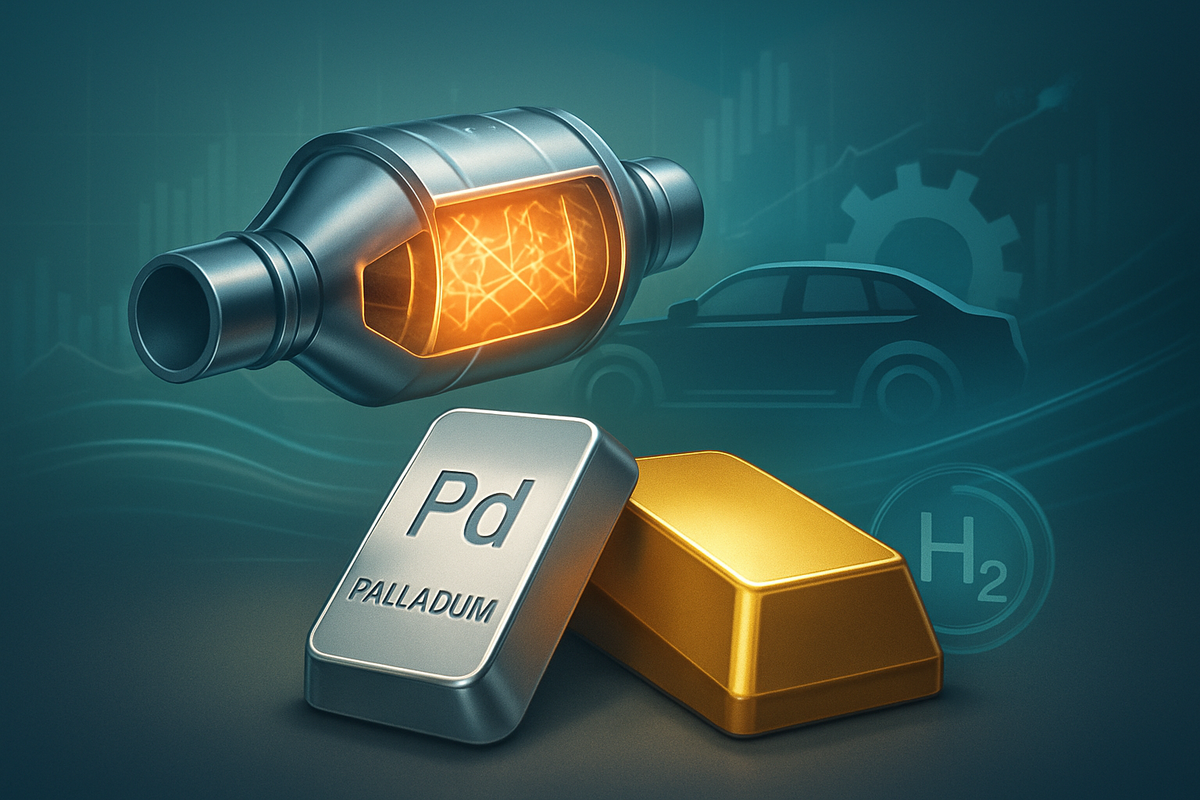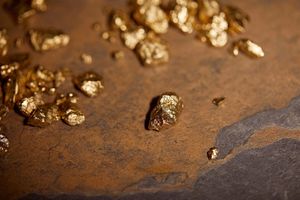Financial News
Palladium's Ascendant Role: A Deep Dive into its Industrial, Investment, and Diversification Value

Palladium, a lesser-known but increasingly vital member of the platinum group metals (PGMs), is rapidly asserting its significance in the global financial landscape. Once overshadowed by its more famous counterparts, gold and platinum, this silvery-white metal has carved out a unique niche, primarily driven by its indispensable role in environmental technologies and its growing appeal as an investment asset. As of November 2025, palladium's market dynamics are characterized by volatility, persistent supply deficits, and a delicate balance between industrial demand and the long-term shadow of electric vehicle (EV) adoption. Its journey, marked by both soaring prices and sharp corrections, underscores its complex position and the immediate implications for investors and industries worldwide.
The immediate implications of palladium's heightened profile are multifaceted. Industries heavily reliant on its catalytic properties, particularly the automotive sector, face ongoing challenges in securing stable supply amidst geopolitical tensions and concentrated production. For investors, palladium offers a compelling, albeit higher-risk, avenue for portfolio diversification, providing exposure to industrial growth and technological advancement that gold, traditionally a safe-haven asset, does not. Its current price of around $1,395 USD/t oz on November 5, 2025, reflects a rebound after a significant decline in 2023 and 2024, signaling renewed investor interest and industrial demand.
Palladium's Unique Trajectory and Market Dynamics
Palladium's market has been a roller coaster, experiencing a significant decline in 2023 and early 2024, with prices dipping to an average of $997.60 in 2024, only to stage a remarkable comeback in 2025, boasting a 41% year-to-date gain by October before a late-October correction. This volatility is deeply rooted in its supply-demand fundamentals. Global palladium production in 2022 was approximately 210 metric tons, supplemented by 90 tons from recycling, primarily from automotive catalysts. Projections for 2025 continue to indicate a supply deficit, estimated between 17,000 and 300,000 ounces, a persistent issue that has historically underpinned its value.
The primary driver of palladium demand, accounting for over 80% of its global consumption, is the automotive industry. It is a critical component in catalytic converters for gasoline-powered and hybrid vehicles, where it transforms harmful pollutants into less toxic substances. Stricter global emission standards, particularly in regions like Europe, China, and the USA, have continuously fueled this demand. Beyond automobiles, palladium's excellent conductivity and corrosion resistance make it vital in electronics, especially in multi-layer ceramic capacitors (MLCCs) found in smartphones and computers. It also finds applications in dentistry, medicine, and as a catalyst in various chemical processes, including hydrogen purification and storage. The U.S. Palladium Market, valued at $2.50 billion in 2025, exemplifies its significant industrial footprint in the country, driven by both emission regulations and advanced electronics.
A unique aspect of palladium's market is its concentrated supply. The majority of the world's palladium is mined in just two countries: Russia and South Africa. This geographical concentration makes the market highly susceptible to geopolitical instability, trade disputes, and mining disruptions, as evidenced by the impact of the Ukraine conflict on global supply chains. These supply-side vulnerabilities, combined with robust industrial demand, contribute significantly to its price volatility and underscore its strategic importance. The ongoing efforts to secure supply, including anti-dumping probes into Russian palladium by countries like the USA, highlight the geopolitical dimensions of this precious metal.
Historically, palladium has demonstrated periods of explosive growth. It steadily appreciated since the 1990s, notably surpassing gold as the most expensive precious metal in January 2019 and maintaining that position for some time. Prices more than tripled between 2016 and 2020, peaking around $3,000 per ounce in February 2022. This strong growth was largely a result of increasing automotive demand and tight supply. However, the subsequent sharp sell-off in 2022, bringing it back to platinum price levels, before its 2025 rebound, illustrates its sensitivity to economic slowdowns and potential substitution threats. This pattern of significant surges followed by corrections is a defining characteristic of palladium's market behavior.
Companies Navigating the Palladium Landscape
The intricate dynamics of the palladium market create both opportunities and challenges for a range of public companies across various sectors. Mining companies, particularly those with significant PGM operations, stand as primary beneficiaries or losers from price fluctuations and supply disruptions.
Key players in palladium mining include Norilsk Nickel (MCX: GMKN) from Russia and Sibanye-Stillwater (NYSE: SBSW) and Anglo American Platinum (JSE: AMS) from South Africa. Norilsk Nickel, being the world's largest producer of palladium, holds immense sway over global supply. Any operational issues, geopolitical sanctions, or changes in production targets from Norilsk Nickel can send ripples through the entire market. Sibanye-Stillwater, with significant operations in both South Africa and the USA (specifically the Stillwater Mine in Montana), is uniquely positioned. A rise in palladium prices directly boosts their revenue and profitability, while sustained low prices or operational challenges, such as labor disputes or regulatory hurdles in South Africa, can significantly impact their bottom line. Anglo American Platinum also benefits from strong palladium prices, but like other South African miners, faces challenges related to power supply and labor relations.
On the demand side, automotive manufacturers are the largest consumers. Companies like Ford Motor Company (NYSE: F), General Motors (NYSE: GM), Toyota Motor Corporation (NYSE: TM), and Volkswagen AG (FWB: VOW3) rely heavily on palladium for their gasoline and hybrid vehicle catalytic converters. While higher palladium prices increase their production costs, potentially squeezing profit margins, the imperative to meet stringent emission standards means they cannot easily forgo its use. This has prompted some automakers to actively research and implement substitution strategies, replacing palladium with the less expensive platinum where technically feasible. This strategic pivot could affect long-term palladium demand from the automotive sector.
Furthermore, companies involved in the recycling of catalytic converters, such as BASF SE (FWB: BAS) through its catalyst division, and specialized recycling firms, stand to gain from high palladium prices. The economic incentive to recover palladium from end-of-life vehicles increases when the metal's value is high, contributing to the secondary supply. Conversely, a sustained downturn in palladium prices could reduce the profitability of recycling operations. Investment vehicles like the Sprott Physical Platinum and Palladium Trust (NYSE Arca: SPPP) and Aberdeen Physical Palladium Shares ETF (NYSE Arca: PALL) also reflect investor sentiment and demand for physical palladium, with their performance directly tied to the metal's spot price.
Wider Significance: Trends, Regulations, and Historical Parallels
Palladium's evolving role fits into several broader industry trends. Firstly, the global push for cleaner air and stricter emission standards continues to be a primary driver. As nations, including the USA, enforce more rigorous environmental regulations, the demand for effective catalytic converters remains robust. This trend provides a foundational demand floor for palladium, even amidst the long-term transition towards electric vehicles. The ongoing debate around internal combustion engine (ICE) bans in certain regions by specific dates creates a complex demand outlook, with short-to-medium term demand remaining strong, but long-term prospects requiring adaptation.
Secondly, the increasing adoption of electric vehicles (EVs) represents a significant long-term challenge to palladium's automotive demand. Since EVs do not require catalytic converters, a complete transition to an all-electric fleet would drastically reduce palladium consumption. This looming shift has spurred extensive research into palladium substitution with platinum, which is more abundant and generally cheaper. This strategic substitution, if widely adopted, could fundamentally alter the demand landscape for palladium and create a more balanced PGM market. Companies like Johnson Matthey Plc (LSE: JMAT), a leading PGM refiner and catalyst manufacturer, are at the forefront of developing these advanced catalyst technologies and recycling processes.
Regulatory and policy implications are substantial. Governments in major automotive markets, by setting emission targets, indirectly influence palladium demand. Additionally, trade policies and sanctions, especially concerning major producers like Russia, can disrupt supply chains and trigger price spikes, as seen with the Ukraine conflict. Anti-dumping investigations into Russian palladium highlight the geopolitical sensitivity surrounding critical raw materials. Historically, similar supply disruptions or sudden surges in industrial demand for other rare metals have led to significant price volatility and strategic shifts in sourcing and recycling efforts. For instance, the rare earth elements market has seen similar geopolitical influences and supply chain concerns.
The comparison to gold in portfolio diversification is crucial. While gold traditionally serves as a safe-haven asset, offering stability during economic downturns and acting as an inflation hedge, palladium's value is more closely tied to industrial activity and technological advancement. This industrial linkage means palladium can offer diversification benefits by providing exposure to cyclical economic growth that gold might not capture. Its tendency to "dance to the beat of its own drummer," with a weaker correlation to other precious metals at times, makes it an attractive component for investors seeking to optimize risk-adjusted returns by balancing gold's stability with palladium's growth potential.
What Comes Next for Palladium
The future of palladium is poised at a critical juncture, shaped by technological advancements, evolving environmental policies, and geopolitical considerations. In the short-term, continued price volatility is highly probable, driven by the persistent supply deficit and any disruptions from major producing regions. Investors should anticipate rapid price movements in response to economic data, automotive sales figures, and news related to mining operations or geopolitical events. The focus on securing stable supply chains will intensify, potentially leading to increased investment in new mining projects outside of Russia and South Africa, although such endeavors have long lead times.
Long-term possibilities for palladium involve a delicate balance between declining automotive demand due to EVs and the emergence of new applications. While the transition to EVs poses a significant headwind, the development of hydrogen fuel cell technology could open a substantial new demand avenue. Palladium's exceptional ability to absorb hydrogen makes it an ideal material for fuel cells, and a "fuel cell boom" could partially offset the reduction in catalytic converter demand. Companies investing in hydrogen economy infrastructure and fuel cell research, such as Plug Power Inc. (NASDAQ: PLUG) or Ballard Power Systems Inc. (NASDAQ: BLDP), could indirectly influence future palladium demand.
Strategic pivots and adaptations will be essential for both producers and consumers of palladium. Mining companies will need to diversify their PGM output, potentially increasing platinum production or exploring other industrial metals. Automakers will continue to refine their substitution strategies, with research into advanced platinum-based catalysts becoming paramount. Market opportunities may emerge in enhanced recycling technologies and secondary refining, as the incentive to recover palladium from end-of-life products grows. Challenges include managing the long-term decline in traditional automotive demand and navigating the complexities of a highly concentrated and geopolitically sensitive supply chain.
Potential scenarios range from a continued slow decline in palladium's prominence if EV adoption accelerates rapidly without significant new industrial applications, to a resurgence if fuel cell technology gains widespread traction. Another scenario involves sustained high prices due to persistent supply constraints and strong demand from hybrid vehicles, which are expected to remain relevant for some time. Investors should closely monitor advancements in battery technology, hydrogen fuel cell development, and the pace of global EV adoption, as these factors will heavily influence palladium's trajectory.
Wrap-up: Assessing Palladium's Lasting Impact
In summary, palladium's journey through the precious metals market has been one of significant dynamism and strategic importance. Its indispensable role in catalytic converters for internal combustion and hybrid vehicles has driven its value for decades, positioning it as a critical industrial metal rather than just a store of value. The metal's unique properties and concentrated supply have led to periods of exceptional price appreciation and considerable volatility, making it a compelling, albeit higher-risk, asset for portfolio diversification alongside traditional safe havens like gold.
Moving forward, the market for palladium will remain highly sensitive to a confluence of factors: global environmental regulations, the pace of electric vehicle adoption, geopolitical stability in key producing regions, and advancements in alternative technologies like hydrogen fuel cells. While the long-term threat from EVs is undeniable, the short-to-medium term demand, bolstered by stringent emission standards and the continued prevalence of hybrid vehicles, suggests that palladium will retain its significance for the foreseeable future. The ongoing efforts in recycling and substitution will also play a crucial role in shaping its supply-demand balance.
Investors should watch for several key indicators in the coming months. These include quarterly reports from major PGM miners for insights into production levels and costs, automotive sales data (particularly for gasoline and hybrid vehicles), and any policy announcements related to emission standards or EV mandates. Furthermore, monitoring geopolitical developments in Russia and South Africa will be crucial, as these can directly impact palladium supply. For those seeking diversification, palladium offers exposure to industrial growth and technological shifts, complementing gold's role as a hedge against economic uncertainty. Its unique market characteristics ensure that palladium will continue to be a focal point in the precious metals sector, demanding careful analysis and strategic consideration.
This content is intended for informational purposes only and is not financial advice
More News
View More



Recent Quotes
View More
Quotes delayed at least 20 minutes.
By accessing this page, you agree to the Privacy Policy and Terms Of Service.



